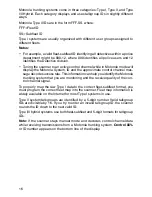
16
Motorola trunking systems come in three categories: Type I, Type II, and Type
I/II Hybrid. Each category displays and uses talkgroup IDs in slightly different
ways.
Motorola Type II IDs are in the form FFF-SS, where;
FFF=Fleet ID
SS=Subfleet ID
Type I systems are usually organized with different user groups assigned to
different fleets.
Notes:
• For example, a valid fleet-subfleet ID identifying all detectives within a police
department might be 000-12, where 000 identifies all police users and 12
identifies the Detective division.
• Tuning the scanner to an active control channel while in Motorola mode will
display the Motorola System. ID and the approximate control channel mes-
sage decode success rate. This information can help you identify the Motorola
trunking system that you are monitoring and the receive quality of the con-
trol channel signal.
To properly map the raw Type I data to the correct fleet-subfleet format, you
must program the correct fleet map into the scanner. Fleet map information is
widely available on the Internet for most Type I systems in use.
Type II system talkgroups are identified by a 5-digit number. Valid talkgroup
IDs are divisible by 16. If you try to enter an invalid talkgroup ID, the scanner
rounds the ID down to the next valid ID.
Type I/II hybrid systems use both fleet-subfleet and 5-digit formats for talkgroup
IDs.
Note:
If the scanner stays manual mode and decodes control channel data
while receiving transmissions from a Motorola trunking system,
Control XX%
or ID number appears on the bottom line of the display.
















































